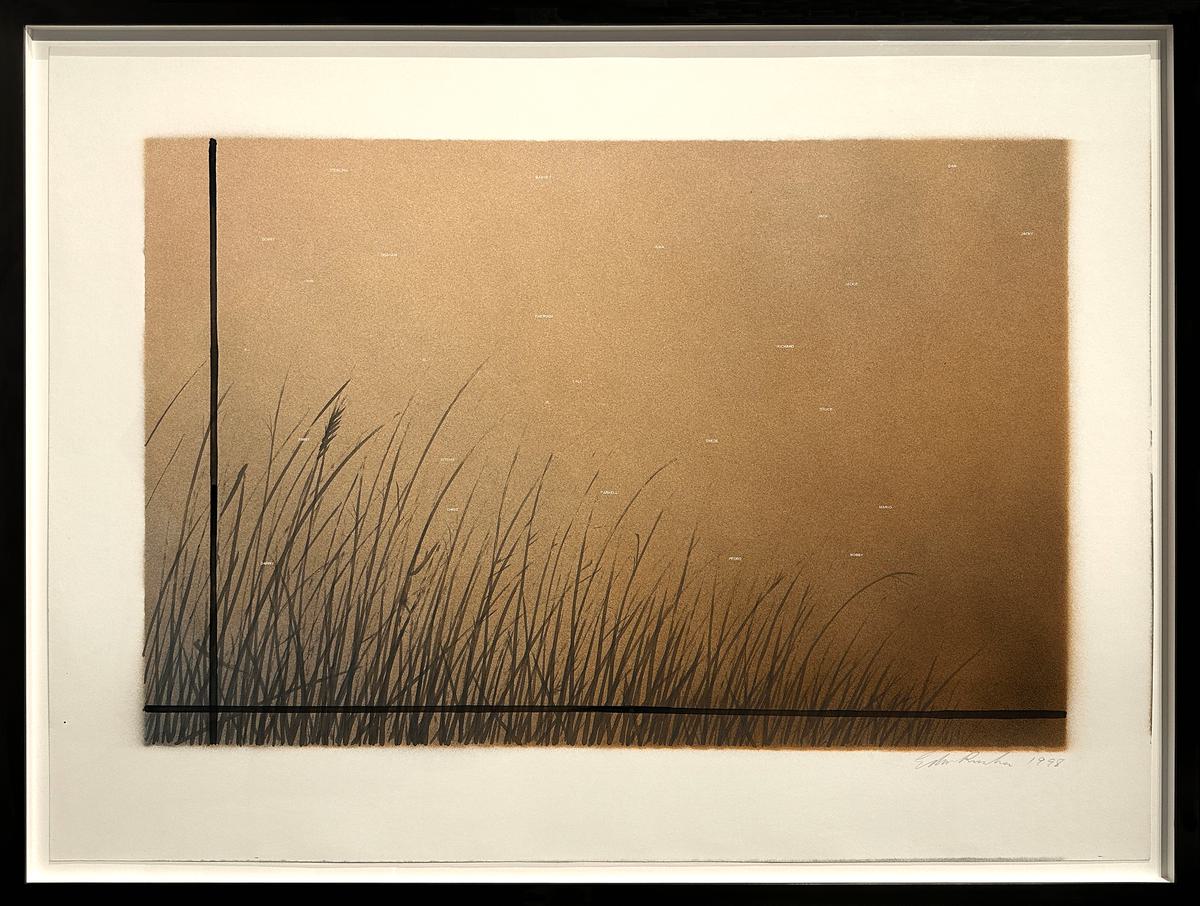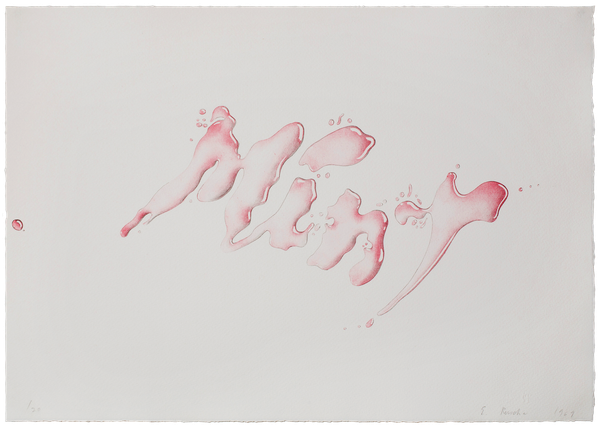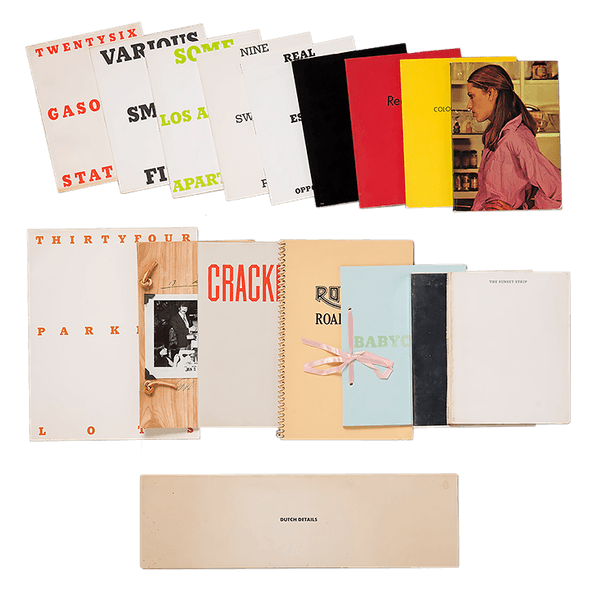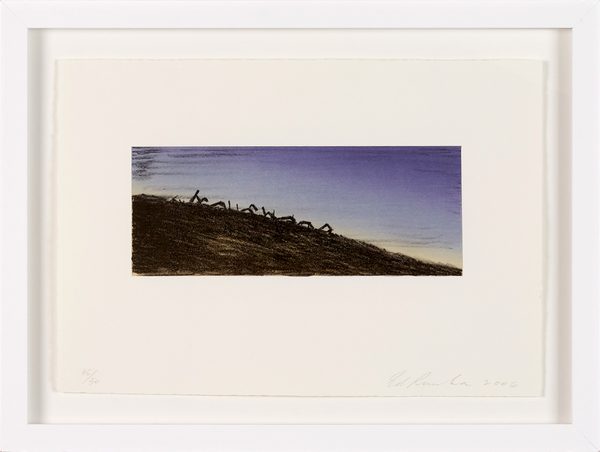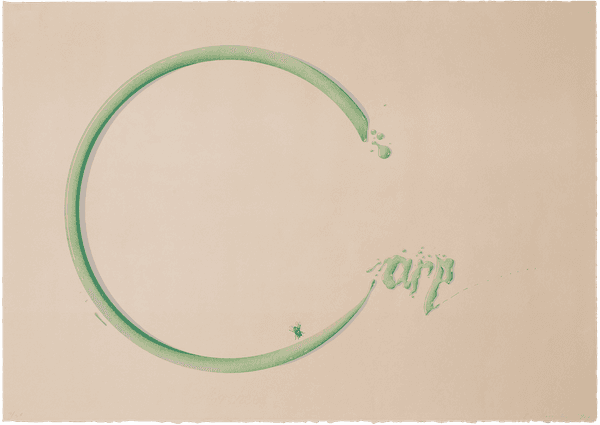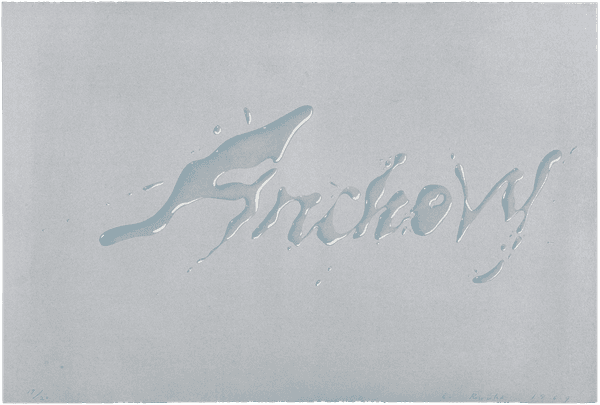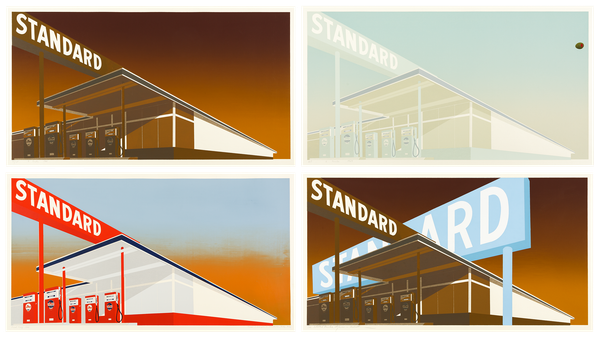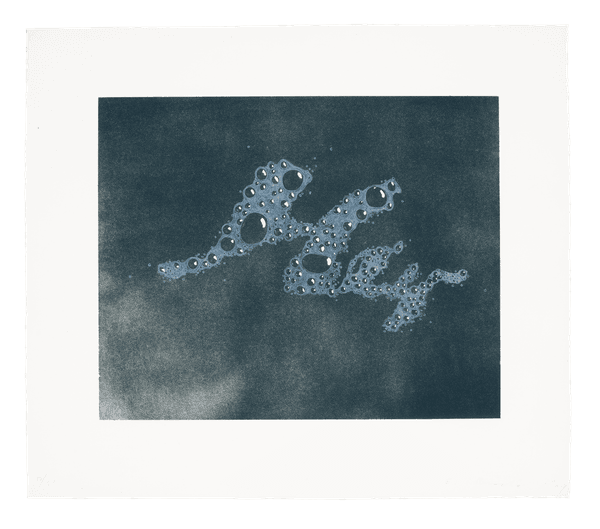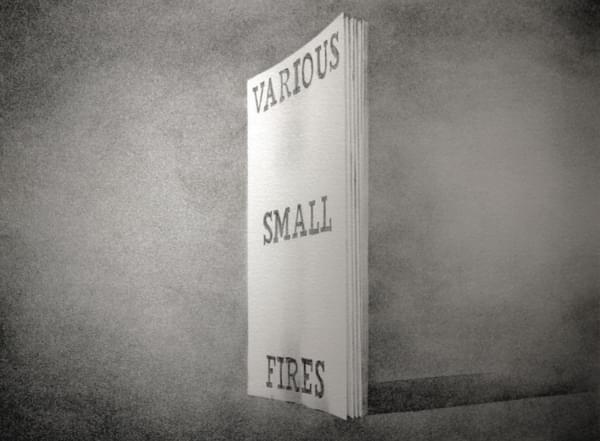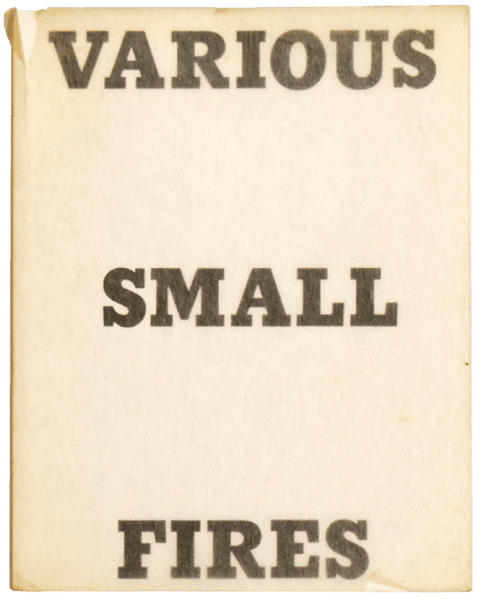Drivers with Two Streets
Drivers with Two Streets belongs to a small group of nineteen works in acrylic and ink made by Ruscha at the beginning of 1998, early amongst which was Artists and features the first names of seven artists encircling the horizontal composition. The names are large and easily distinguishable - Basil; Roy; Jasper; Kurt; Max; Walker and Franz. They signpost his life as a young artist. Basil Wolverton was a cartoonist Ruscha loved as a child, while a painting by Roy Lichtenstein, encountered on his first visit to Leo Castelli Gallery in 1961 "just floored me" he has said. Works by Jasper Johns amounted to nothing less than "the reason for my being an artist." Ruscha has cited Kurt Schwitters and Max Ernst as other significant early guides, the photography of Walker Evans as a "profound influence" and the austere palette of Franz Kline as an inspiration for his black-and-white paintings of the 1980s.
That Artists has been retained in the artist's personal collection and is a promised gift to the Joslyn Art Museum in Omaha, Nebraska, where Ruscha was born in 1937 and lived for a few years before moving to Oklahoma City, is another autobiographical connection. Indeed, the vegetation depicted in the lower half of both Artists and Drivers with Two Streets might well be from the Midwestern wheat fields he drove through on what would turn out to be a permanent move to Los Angeles in 1956. These both seem like unusually intimate works for Ruscha, though their personal references are filtered through impersonal, even automated, methods. While the grass blades were detailed in assiduous acrylic strokes, the rust-coloured backgrounds were applied with an airbrush and the names stenciled in Ruscha's own Boy Scout Utility Modern lettering, a workaday typeface that he likes because it "doesn't say anything." Acknowledging his influences and heroes by first name only lends camaraderie, but it also delays or outright prevents a viewer's apprehension of their identities.
These dynamics - disclosure/withholding, manual/mechanical, familiarity/detachment underpin the other works in the suite to which both Artists and Drivers with Two Streets belong. Made in 1998, each arrays a selection of first names, minutely rendered, against backgrounds that tend to be spare and monochromatic save for fringes of flora or the occasional hint of sunshine. The works namecheck various pioneers of their fields - inventors and composers, while the rest are dedicated to athletic figures: boxers, race-car drivers and stunt-people.
The works display few of the manual marks or indexical traces regularly invoked as distinguishing drawing, in most the names were lettered with a Leroy Lettering Set (a mechanical scribing implement), printed at a reduced size, and arranged. A screen was then made from this arrangement and the names were silkscreened with a small squeegee onto previously prepared backgrounds. This use of precise, labour-intensive printmaking techniques to produce unique works left little opportunity for alteration. In Ruscha's words, he had "one shot to get it right." Like most of his drawings, they are what he would describe as "things in themselves," not intermediary steps in the development of some final image or ideal form. He has long maintained that "I'm more interested in end results than I am in means to the end". While Ruscha pursues certain series simultaneously in more than one medium, these works have no counterparts among his paintings on canvas and stand alone as a body of work.
A boxing and motorsport enthusiast, Ruscha lets slip something of himself in this series, if little of his creative process. His long fascination with automobiles and car culture is much documented and has informed his work since the beginning of his career. Motor, a gunpowder and pastel work of 1970 in the collection of the Whitney Museum of American Art, is an relatively early example of this preoccupation however motoring references are strewn throughout the artist's canon from Twentysix Gasoline Stations onward.
The construction of Ed Ruscha's Drivers with Two Streets is also a homage to the sheer historical romance of racing fast cars. The two streets of the title frame the composition on two sides, intersecting at the lower left corner of the sheet. The silhouettes of long grass stalks sway as if being stirred by the passing draught of a motor car. Within the composition, a constellation of names can be seen, all first names of famous racing drivers of the past that have personal meaning for the artist. The tiny words demanding up-close contemplation.
The names are:
STIRLING (Stirling Moss - 16 Grands Prix wins - "the greatest driver never to win the Formula One World Championship")
BOBBY (Bobby Allison - three time winner of the Daytona 500)
GRAHAM (Graham Hill - the only winner of the Indianapolis 500, the 24 Hours of Le Mans, and the Formula One World Championship - five time winner of the Monaco Grand Prix)
JOHN (John Surtees - the only winner of both the Formula One World Championship and the Grand Prix motorcycle World Championship)
A.J. (Anthony Joseph Foyt Jr. - the only driver to win the Indianapolis 500, the Daytona 500, the 24 Hours of Daytona, and the 24 Hours of Le Mans)
AL (Alfred "Al" Unser Sr. - four time winner of the Indianapolis 500)
JIMMY (Jim Clark - double winner of the Formula One World Championship and winner of the Indianapolis 500)
DANNY (Daniel John Sullivan III - winner of the Indianapolis 500)
CHRIS (Chris Amon - winner of the 24 Hours of Le Mans - known as one of the unluckiest drivers in Formula One history)
RITCHIE (Paul Richard "Ritchie" Ginther - Hollywood-born winner of the 1965 Mexican Grand Prix)
PARNELLI (Parnelli Jones - winner of the Indianapolis 500 - at 89, he remains the oldest living winner of the title)
JR. (Robert Glenn Johnson Jr. - "Junior Johnson" - winner of the Daytona 500)
CALE (William Caleb "Cale" Yarborough - four time winner of the Daytona 500)
EMERSON (Emerson Fittipaldi - double winner of the Formula One World Championship and double winner of the Indianapolis 500)
BARNEY (Berna Eli "Barney" Oldfield - set the world speed record in 1910, driving at 131.724 mph in his Blitzen Benz at Daytona Beach)
JUAN (Juan Manuel Fangio - dominated the first decade of Formula One racing, winning the World Drivers' Championship five times)
SWEDE (David Earl "Swede" Savage Jr. - immensely talented IndyCar driver who died at the age of 26 following a crash at the 1973 Indianapolis 500)
PEDRO (Pedro Rodríguez de la Vega - double Grands Prix winner - won the 1968 24 Hours of Le Mans in a Ford GT40)
BOBBY (Robert William "Bobby" Unser - three-time winner of the Indianapolis 500)
MARIO (Mario Gabriele Andretti - to date, the only winner of the Indianapolis 500, the Daytona 500 and the Formula One World Championship)
BRUCE (Bruce McLaren - four time Grands Prix winner - 24 Hours of Le Mans winner and founder of the McLaren F1 racing team)
RICHARD (Richard Lee Petty - seven time winner of the Daytona 500 - nicknamed "The King")
JACKIE (Sir John Young "Jackie" Stewart - "the Flying Scot" - competed in nine Formula One seasons, of those winning the World Drivers' Championship three times and coming second twice)
JACK (Sir John Arthur "Jack" Brabham - three time winner of the Formula One World Championship and founder of the Brabham F1 racing team)
DAN (Daniel Sexton "Dan" Gurney - after winning the 24 Hours of Le Mans he sprayed champagne while celebrating on the podium, creating the now-famous tradition)
JACKY (Jacques Bernard "Jacky" Ickx - six time 24 Hours of Le Mans winner)
[some explanatory text abridged and adapted from Lisa Turvey, Edward Ruscha Catalogue Raisonné of the Works on Paper: Volume Three: 1998-2018]
Drivers with Two Streets
- Artist
- Ed Ruscha (b.1937)
- Title
- Drivers with Two Streets
- Medium
- Acrylic and ink on paper
- Date
- 1998
- Size
- 30 x 40 ¼ in : 76.4 x 102.1 cm
- Frame Size
- 32 ½ x 43 ¼ in : 82.4 x 110.1 cm
- Inscriptions
- Signed and dated lower right in pencil. Inscribed with a list of 26 racing drivers in ink verso
- Provenance
- Anthony d'Offay Gallery, London
Sprüth Magers, Munich
Private collection, Geneva
Simon Lee Gallery, London
James Corcoran Gallery, Los Angeles and John Berggruen Gallery, San Francisco
Dranoff Fine Art, New York
Franklin Parrasch Gallery, New York
Private collection, Hong Kong - Exhibited
- Edward Ruscha, Galerie Marian Goodman, Paris, Jun 20-Jul 30, 1998
Ed Ruscha: Oeuvres sur papier, Galerie 1900-2000, Paris, Oct 15-Nov 15, 2008
The Road to Here: Robert Bechtle, Ed Ruscha, Wayne Thiebaud, Zoe Crosher, Dave Muller and Jonas Wood, John Berggruen Gallery, San Francisco, Feb 23-Mar 20, 2010
Nice, Hot Vegetables: Ed Ruscha Works on Paper, Richard Gray Gallery, New York, Oct 6-Nov 19, 2011 - Literature
- Ed Ruscha: Oeuvres sur papier, Galerie 1900-2000, Paris, Oct 15-Nov 15, 2008, p.34 (col. illus.)
Lisa Turvey, Edward Ruscha Catalogue Raisonné of the Works on Paper: Volume Three: 1998-2018, Yale University Press, New Haven and London, 2023, p.53, D.1998.18 (col. illus.) and discussed p.11 - Registration
- This work is registered with the Edward Ruscha studio under number D.98.18 (label verso)
- Reference
- A22-105
- Download PDF
- Status
- Available
Available Artists
- Albers Anni
- Ancart Harold
- Andre Carl
- Avery Milton
- Baldessari John
- Barnes Ernie
- Calder Alexander
- Castellani Enrico
- Clough Prunella
- Crawford Brett
- Dadamaino
- de Tollenaere Saskia
- Downing Thomas
- Dyson Julian
- Elsner Slawomir
- Freud Lucian
- Gadsby Eric
- Gander Ryan
- Guston Philip
- Haring Keith
- Hartung Hans
- Hayes David
- Held Al
- Hepworth Barbara
- Hill Anthony
- Hitchens Ivon
- Hockney David
- Hutchinson Norman Douglas
- Jenney Neil
- Katz Alex
- Kentridge William
- Knifer Julije
- Kusama Yayoi
- Le Parc Julio
- Leciejewski Edgar
- Léger Fernand
- Levine Chris
- Marchéllo
- Martin Kenneth
- Mavignier Almir da Silva
- Miller Harland
- Mitchell Joan
- Modé João
- Moore Henry
- Morellet François
- Nadelman Elie
- Nara Yoshitomo
- Nesbitt Lowell Blair
- Nicholson Ben
- O'Donoghue Hughie
- Pasmore Victor
- Perry Grayson
- Picasso Pablo
- Pickstone Sarah
- Prehistoric Objects
- Quinn Marc
- Riley Bridget
- Ruscha Ed
- Sedgley Peter
- Serra Richard
- Shrigley David
- Smith Anj
- Smith Richard
- Soto Jesús Rafael
- Soulages Pierre
- Spencer Stanley
- Taller Popular de Serigrafía
- The Connor Brothers
- Turk Gavin
- Vasarely Victor
- Vaughan Keith
- Whiteread Rachel
- Wood Jonas
